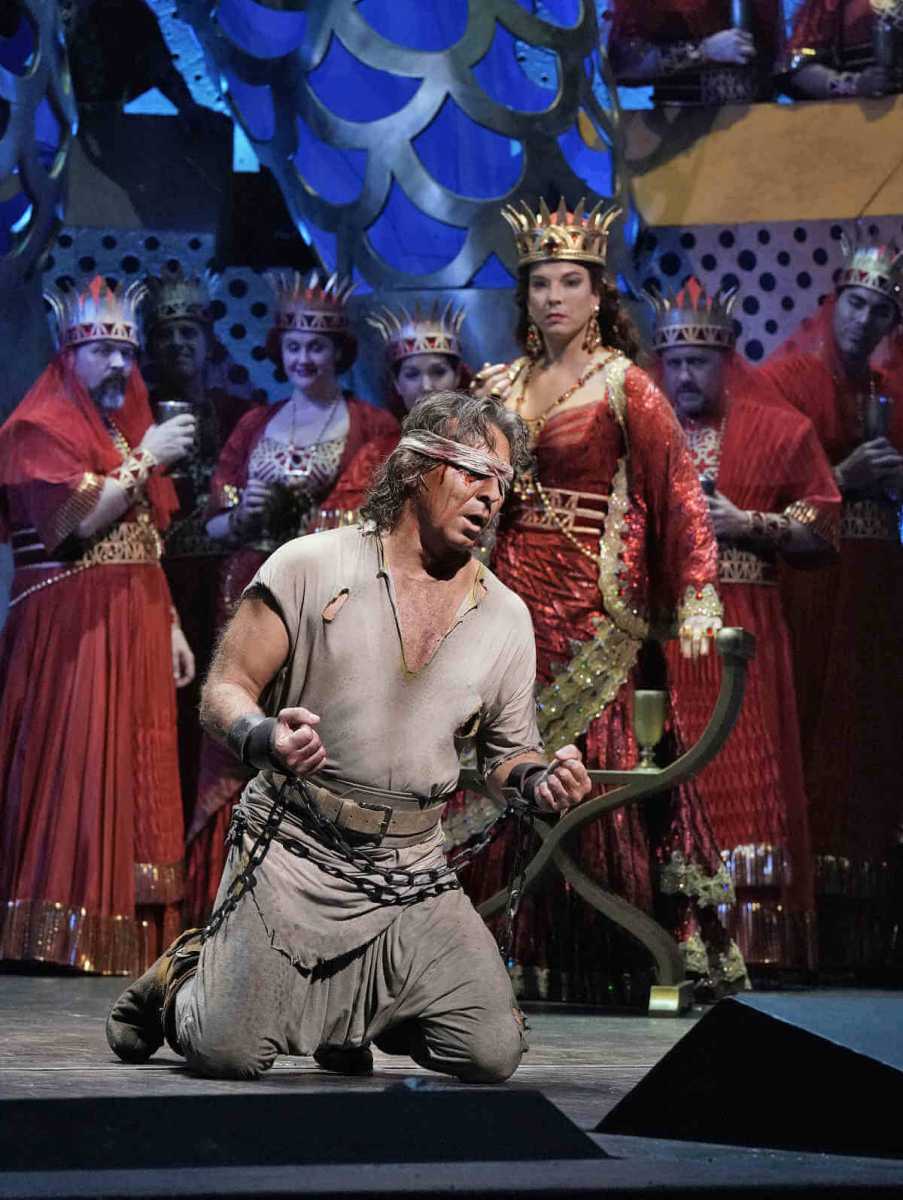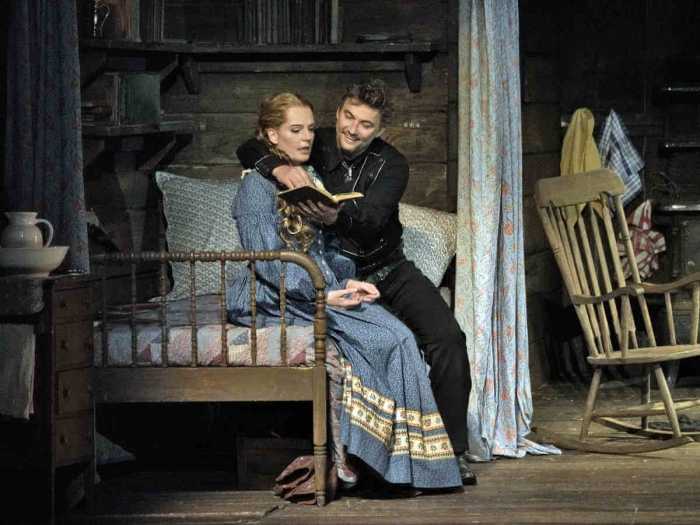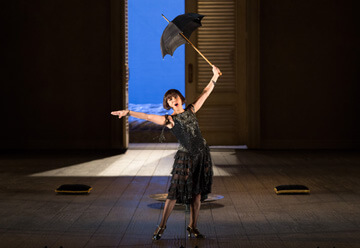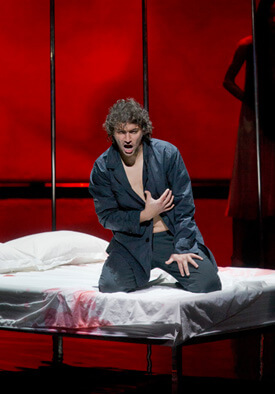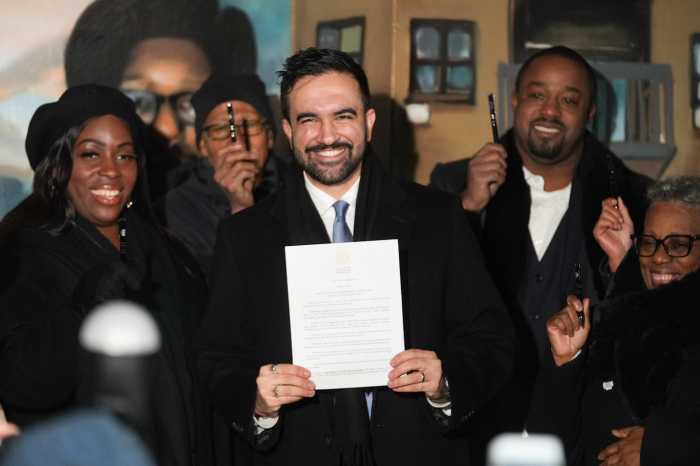The Metropolitan Opera opened the 2018-2019 season on September 24 with a high-powered new production of Camille Saint-Saëns’ “Samson et Dalila.” The promise of the Met debut of Tony award-winning Broadway director Darko Tresnjak (“A Gentleman’s Guide to Murder”) and the reteaming of Roberto Alagna and Elina Garanca (who sizzled in the 2009 premiere of “Carmen”) failed to deliver on opening night. Garanca’s Dalila struck critical observers as chilly and small of voice. Alagna, suffering from a cold, lost his voice completely in Act III. Sir Mark Elder’s lead-footed conducting threw a wet blanket over the proceedings. Tresnjak’s production was denounced as vulgar and trivial.
Seen on October 1, a few of these issues seemed to be sorting themselves out but basic problems remain. Alagna in Act I initially sounded vocally recovered from his indisposition — his bright tenor had regained the clarity, ring, and focus it lacked on opening night. As always, his native French diction and dramatically incisive declamation of text give great pleasure. Alagna still presents a handsome stage presence and moves well. Unfortunately, in Act II, the high B-flat that Samson delivers in response to Dalila’s “Mon coeur s’ouvre à ta voix” splayed due to phlegm (though Alagna stubbornly held on to the note attempting to steady and focus it) and Samson’s final “Trahison!” was equally strained. He canceled Act III, hastening the Met debut of Lithuanian tenor Kristian Benedikt. The understudy sang with a sturdy and secure tone that lacked tonal glamor but rose to all the climaxes with confidence. He was rewarded for his efforts with an enthusiastic ovation at the final curtain call.
Dalila’s contralto tessitura proved uncongenial to Garanca’s sinuous, refined mezzo-soprano. Dalila does a lot of her heavy vamping in the lowest register, where Garanca’s high mezzo-soprano loses power and resonance. Her voice gains in size and overtones in the upper register, resulting in several exultant high climaxes in the arias and duets. Garanca’s dry smallish tone and cool, calculating persona resulted in a Dalila who despite great personal beauty failed to produce much heat or even warmth. In fact, the sexual chemistry that Alagna and Garanca displayed in “Carmen” less than a decade ago was largely absent. That may be due to Tresnjak’s generalized, workmanlike direction, which failed to illuminate interpersonal relationships. Alagna’s Samson brooded and pleaded more like the generic lovelorn romantic hero than a biblical prophet in spiritual crisis. Garanca’s Dalila did evince some conflicted feelings and remorse witnessing Samson’s abuse at the hands of the Philistines.
The lower voices failed to impress: Laurent Naouri as the High Priest of Dagon provided incisive diction and characterization but his bass-baritone sounds worn and gnarled. Dmitry Belosselskiy’s bass faded into nothing on the lowest notes of the Old Hebrew’s music, and Elchin Azizov blustered noisily to middling effect as Abimélech. Donald Palumbo’s chorus sounded marvelous whether portraying pious Hebrews or decadent Philistines. No one was aided by Elder’s insipid conducting. The first act in particular lacked any kind of rhythmic pulse and Elder’s slow tempos hampered his vocally challenged mezzo and tenor. In Act III, the maestro roused himself from his torpor to deliver an exciting, flashy “Bacchanale.”
Tresnjak’s traditional production is an updated tribute to Cecil B. DeMille and the Hollywood technicolor costume spectacular genre of the 1950s. Alexander Dodge’s towering sets resembled an upscale resort hotel in Dubai while Linda Cho’s costumes piled on the glitz — yards of gold lamé and shimmering gauze drapery all covered with feathers and jewels. Garanca was done up in full harem girl drag in homage to Hedy Lamarr. Donald Holder’s lighting spilled garish blue, pink, and lavender hues all over the stage. The production style is flashy and fun, and the towering statue of Dagon in Act III is an eye-popper.
DeMille would not have approved of the homoerotic go-go boy writhing around the Dagon statue that Austin McCormick of Company XIV choreographed for Act III’s orgy (Saint-Saëns would have appreciated it much more). DeMille, however, didn’t cop out in providing some special effects for the fall of the temple of Dagon. There were no temple pillars for Samson to be chained to and pull down. A mere puff of stage smoke and a flash of white light while the chorus and principals froze onstage provided a lame climax for the evening.
In several ways DeMille and Saint-Saëns are a match made in heaven: Both men were attracted equally to religion and sex. Both men used biblical stories to peddle spectacle and sensuality to bourgeois audiences while adding a pious moral at the end to make it all “classy” and uplifting. Saint-Saëns’ music goes from Bach oratorio in Act I to gaudy French grand opéra exoticism, with echoes of Meyerbeer and Offenbach in Acts II and III. The element of kitsch binds Saint-Saëns and DeMille together. Tresnjak’s “Samson et Dalila” production embraces kitsch without shame, irony, or condescension.
Critics and intellectuals bristle at unironic kitsch and flashy spectacle but most audience members don’t have such scruples as Saint-Saëns and DeMille well understood. But what kitsch spectacle needs is charismatic performers who devour the stage — Garanca and Alagna were carefully picking away at their parts rather than devouring them and the stage whole. I hope later performances will provide lustier vocalism and zippier conducting because this “Samson” has most other elements necessary for a colorful, splashy grand opera spectacle.
The Saturday, October 20 matinee performance of “Samson et Dalila” will be transmitted at 12:55 p.m. EDT worldwide as part of the Met’s Live in HD series.

